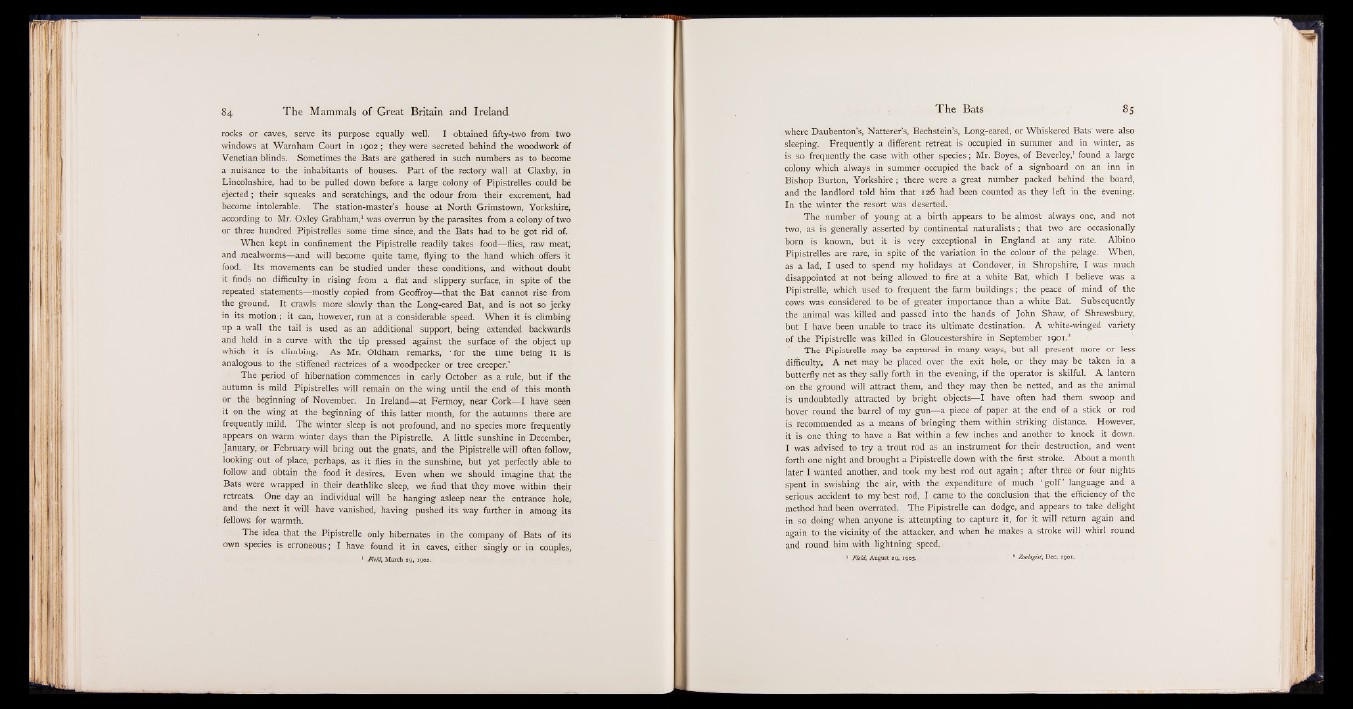
rocks or caves, serve its purpose equally well. I obtained fifty-two from two
windows at Warnham Court in 1902; they were secreted behind the woodwork of
Venetian blinds. Sometimes the Bats are gathered in such numbers as to become
a nuisance to the inhabitants of houses. Part of the rectory wall at Claxby, in
Lincolnshire, had to be pulled down before a large colony of Pipistrelles could be
ejected; their squeaks and scratchings, and the odour from their excrement, had
become intolerable. The station-master’s house at North Grimstown, Yorkshire^
according to Mr. Oxley Grabham,1 was overrun by the parasites from a colony of two
or three hundred Pipistrelles some time since, and the Bats had to be got rid of.
When kept in confinement the Pipistrelle readily takes food— flies, raw meat;
and mealworms— arid will become quite tame, flying to the hand which offers it
food. Its movements can be studied under these conditions, and without doubt
it finds no difficulty in rising from a flat and slippery surface, in spite of the
repeated statements— mostly copied from Geoffroy— that the Bat cannot rise from
the ground. It crawls more slowly than the Long-eared Bat,. and is not so jerky
in its motion; it can, however, run at a considerable speed. When it is climbing
up a wall the tail is used as an additional support, being extended backwards
and held in a curve with the tip pressed against the surface of the object up
which' it is climbing. As Mr. Oldham remarks, * for the time being it is
analogous to the stiffened rectrices of a woodpecker or tree creeper.’
The period of hibernation commences in early October as a rule, but if the
autumn is mild Pipistrelles will remain On the wing until the end of this month
or the beginning of November. In Ireland— at Fermoy, near Cork-—I have seen
it on the wing at the beginning of this latter month, for the autumns there are
frequently mild. The winter sleep is not profound, and no species more frequently
appears on warm winter days than the Pipistrelle. A little sunshine in December,
January, or February will bring out the gnats, and the Pipistrelle will often follow,
looking out of place, perhaps, as it flies in the sunshine, but yet perfectly able to
follow and obtain the food it desires. Even when we should imagine that the
Bats were wrapped in their deathlike sleep, we find that they move within their
retreats. One day an individual will be hanging asleep near the entrance hole,
and the next it will have vanished, having pushed its way further in among its
fellows for warmth.
The idea that the Pipistrelle only hibernates in the company of Bats of its
own species is erroneous; I have found it in caves, either singly or in couples,
1 Field, March 29, 1902.
where Daubenton’s, Natterer’s, Bechstein’s, Long-eared, or Whiskered Bats were also
sleeping. Frequently a different retreat is occupied in summer and in winter, as
1^; so frequently the case with other species; Mr. Boyes, of Beverley,1 found a large
colony which always in summer occupied the back of a signboard on an inn in
Bishop Burton, Yorkshire; there were a great number packed behind the board,
and the landlord told him that 126 had been counted as they left in the evening.
In the winter the resort was deserted.
The number of young at a birth appears to be almost always one, and not
two, as is generally asserted by continental naturalists; that two are occasionally
born is known, but it is very exceptional in England at any rate. Albino
Pipistrelles are rare, in spite of the variation in the colour of the pelage. When,
as a lad, I used to spend my holidays at Condover, in Shropshire, I was much
disappointed at not being allowed to fire at a white Bat, which I believe was a
Pipistrelle, which used to frequent the farm buildings; the peace of mind of the
cows was considered to be of greater importance than a white Bat. Subsequently
the animal was killed and passed into the hands of John Shaw, of Shrewsbury,
but I have been unable to trace its ultimate destination. A white-winged variety
of the Pipistrelle was killed in Gloucestershire in September 1901.2
The Pipistrelle may be captured in many ways, but all present more or less
difficulty^ A net may be placed over the exit hole, or they may be taken in a
butterfly net as they sally forth in the evening, if the operator is skilful. A lantern
on the ground will attract them, and they may then be netted, and as the animal
is undoubtedly attracted by bright objects— I have often had them swoop and
hover round the barrel of my gun— a piece of paper at the end of a stick or rod
is recommended as a means of bringing them within striking distance. However,
it is one thing to have a Bat within a few inches and another to knock it down.
I was advised to try a trout rod as an instrument for their destruction, and went
forth one night and brought a Pipistrelle down with the first stroke. About a month
later I wanted another, and took my best rod out again; after three or four nights
spent in swishing the air, with the expenditure of much ‘ golf’ language and a
serious accident to my best rod, I came to the conclusion that the efficiency of the
method had been overrated. The Pipistrelle can dodge, and appears to take delight
in so doing when anyone is attempting to capture it, for it will return again and
again to the vicinity of the attacker, and when he makes- a stroke will whirl round
and round him with lightning speed.
Field, August 29, 1903. * Zoologist, Dec. 1901.